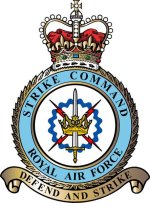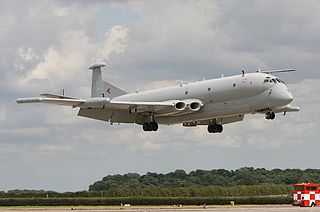
The Hawker Siddeley Nimrod is a retired maritime patrol aircraft developed and operated by the United Kingdom. It was an extensive modification of the de Havilland Comet, the world's first operational jet airliner. It was originally designed by de Havilland's successor firm, Hawker Siddeley; further development and maintenance work was undertaken by Hawker Siddeley's own successor companies, British Aerospace and, later, BAE Systems.

The Royal Air Force's Strike Command was the military formation which controlled the majority of the United Kingdom's bomber and fighter aircraft from 1968 until 2007 when it merged with Personnel and Training Command to form the single Air Command. It latterly consisted of two formations – No. 1 Group RAF and No. 2 Group RAF. The last Commander-in-Chief was Air Chief Marshal Sir Joe French.

The former Royal Air Force Far East Air Force, more simply known as RAF Far East Air Force, was the Command organisation that controlled all Royal Air Force assets in the east of Asia. It was originally formed as Air Command, South East Asia in 1943 during the Second World War. In 1946, this was renamed RAF Air Command Far East, and finally Far East Air Force in June 1949.

No. 206 Squadron is a Test and Evaluation Squadron of the Royal Air Force. Until 2005 it was employed in the maritime patrol role with the Nimrod MR.2 at RAF Kinloss, Moray. It was announced in December 2004 that 206 Squadron would disband on 1 April 2005, with half of its crews being redistributed to Nos. 120 and 201 Squadrons, also stationed at Kinloss. This was a part of the UK Defence Review called Delivering Security in a Changing World; the Nimrod MR.2 fleet was reduced in number from 21 to 16 as a consequence.

Royal Air Force Kinloss, or more simply RAF Kinloss, is a former Royal Air Force station located near the village of Kinloss, on the Moray Firth in the north east of Scotland, UK.

Number 120 Squadron or No. CXX Squadron is a squadron of the Royal Air Force which was established as a Royal Flying Corps unit late in World War I, disbanded a year after the end of the war, then re-established as a RAF Coastal Command squadron during World War II. Although disbanded again a month after Victory in Europe Day, during and after World War II it operated almost continuously, with maritime patrol aircraft; most recently with the Hawker Siddeley Nimrod, based at RAF Kinloss in Scotland until the type's withdrawal in March 2010. The squadron was disbanded again the following year. No. 120 Squadron stood up again in April 2018 at RAF Lossiemouth and became the first squadron to be equipped with the Boeing Poseidon MRA1 anti-submarine warfare (ASW) aircraft on 31 October 2019.
Air Chief Marshal Sir Brian Kevin Burridge, is a retired Royal Air Force officer. A former Nimrod pilot, Burridge was in overall command of British forces under Operation Telic during the 2003 invasion of Iraq.

The Commander-in-Chief Fleet (CINCFLEET) was the admiral responsible for the operations of the ships, submarines and aircraft of the British Royal Navy from 1971 until April 2012. The post was subordinate to the First Sea Lord, the professional head of the Naval Service. In its last years, as the Navy shrank, more administrative responsibilities were added.

No. 1 Group of the Royal Air Force is one of the two operations groups in RAF Air Command. Today, the group is referred to as the Air Combat Group, as it controls the RAF's combat fast-jet aircraft and has airfields in the UK, as well as RAF Support Unit Goose Bay at CFB Goose Bay in Canada. The group headquarters is located alongside Headquarters Air Command at RAF High Wycombe, Buckinghamshire. The other operational group is No. 2 Group RAF.

No. 3 Group RAF of the Royal Air Force was an RAF group first active in 1918, again between 1923 and 1926, then as part of RAF Bomber Command from 1936 to 1967, and recently part of RAF Strike Command from 2000 until it disbanded on 1 April 2006.
No. 203 Squadron RAF was originally formed as No. 3 Squadron Royal Naval Air Service. It was renumbered No. 203 when the Royal Air Force was formed on 1 April 1918.

Air Headquarters Malta was an overseas command of the Royal Air Force (RAF) during the Second World War. It was established on 28 December 1941 by renaming RAF Mediterranean under Air Vice Marshal Hugh Lloyd. Lloyd was named Air Officer Commanding in Malta on 1 June 1941.

Royal Air Force Pitreavie Castle or RAF Pitreavie Castle was a station of the Royal Air Force located at Pitreavie Castle in Dunfermline and near Rosyth, Fife, Scotland.
Air Marshal Sir Alan Cyril Davies, was a Royal Air Force officer who served as Deputy Commander of RAF Strike Command in 1977.

Eastern Area Command was one of several geographically based commands raised by the Royal Australian Air Force (RAAF) during World War II. It was formed in May 1942, and controlled units located in New South Wales and southern Queensland. Headquartered in Sydney, Eastern Area Command's responsibilities included air defence, aerial reconnaissance and protection of the sea lanes within its boundaries. Its flying units operated fighters, reconnaissance bombers, and dive bombers, and concentrated on convoy escort, maritime patrol and anti-submarine warfare. The size of the area was such that the RAAF twice considered splitting it, but nothing came of this.

Southern Area Command was one of several geographically based commands raised by the Royal Australian Air Force (RAAF) during World War II. It was formed in March 1940, and initially controlled units located in Victoria, Tasmania, South Australia and southern New South Wales. Headquartered in Melbourne, Southern Area Command was responsible for air defence, aerial reconnaissance and protection of the sea lanes within its boundaries. From 1942 its operational responsibilities excluded New South Wales.

Allied Command Channel (ACCHAN) was one of three major North Atlantic Treaty Organization (NATO) commands from 1952 to 1994. Commander-in-Chief Channel was a Major NATO Commander (MNC).

No. 19 Group was a group of the Royal Air Force, active during 1918, and then from 1941-1969.

The Hawker Siddeley Nimrod R1 is a signals intelligence (reconnaissance) aircraft formerly operated by the Royal Air Force. The aircraft was a conversion of the existing Nimrod maritime patrol aircraft, with all of the electronic equipment and armament optimised for anti-submarine and anti-ship warfare, and search and rescue, replaced by equipment for the gathering of communications intelligence and electronic intelligence.
At the end of the Cold War in 1989, the Royal Air Force (RAF) structure was as follows:

















